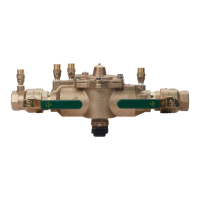TYPICAL FLOW RATES AS SIZED BY FLOOR DRAIN MANUFACTURERS
2" 55 GPM 5" 350 GPM
3" 112 GPM 6" 450 GPM
4" 170 GPM 8" 760 GPM
Figure 4
Relief Valve Discharge Rates
1
⁄2" – 1"
45
40
35
30
25
20
15
10
5
0
0 10 20 30 40 50 60 70 80 90 100 150
Zone Pressure psi
Flow Rate gpm
1
⁄2"
3
⁄4" M2
1" M2
X
1
1
⁄4" – 3"
350
300
250
200
150
100
50
0
0 10 20 30 40 50 60 70 80 90 100 150
Zone Pressure psi
Flow Rate gpm
2
1
⁄2" – 3"
2" M2
1
1
⁄4" – 1
1
⁄2" M2
3
NOTICE
Special considerations are necessary when testing as sem-
blies installed on Fire Prevention Systems.
Fire Protection System Installations: The National Fire
Protection Agency (NFPA) Guidelines require a confirming flow
test be con duct ed whenever a “main line
” valve such as a back-
flow assembly or the shutoff valves have been operated. Certified
testers of backflow assemblies must conduct this confirming test.
F. The backflow preventers must be inspected periodically for any
discharge from the relief valve which provides a visual indication
of need for cleaning or repair of check valves. Also testing for
proper operation of the device should be made periodically in
compliance with local codes, but at least once a year or more
often, depending upon system
conditions.
The relief vent discharges water when, during no-flow periods,
the first check valve is fouled or the inlet pressure to the device
drops sufficiently due to upstream pressure fluctuations to affect
the required operating differential between the inlet pressure and
reduced pressure zone. Otherwise, such relief (spitting) can
occur when the second check is fouled during emergency back-
flow or resulting from a water hammer condition. (For more
information, download Troubleshooting Guide S-TSG at
watts.com.)

